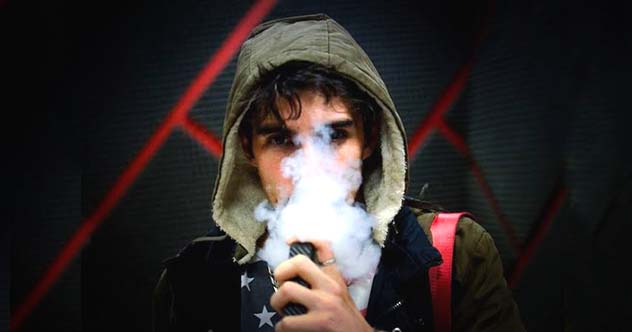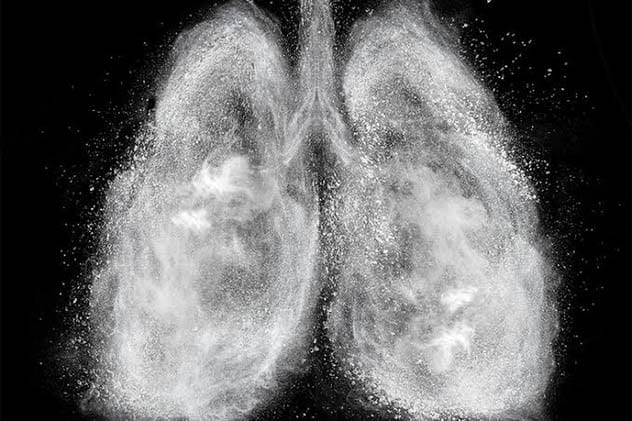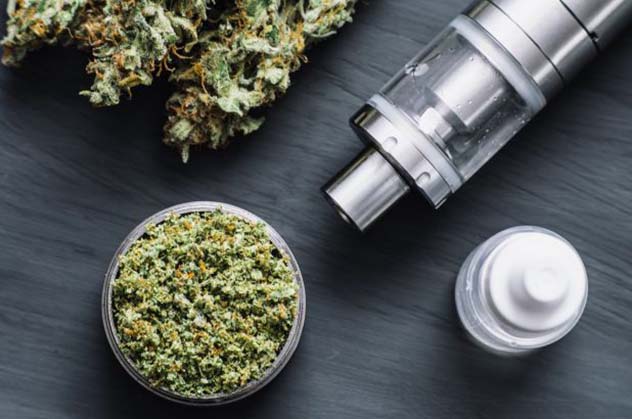 Movies and TV
Movies and TV  Movies and TV
Movies and TV  History
History 10 Things You Didn’t Know About the American National Anthem
 Technology
Technology Top 10 Everyday Tech Buzzwords That Hide a Darker Past
 Humans
Humans 10 Everyday Human Behaviors That Are Actually Survival Instincts
 Animals
Animals 10 Animals That Humiliated and Harmed Historical Leaders
 History
History 10 Most Influential Protests in Modern History
 Creepy
Creepy 10 More Representations of Death from Myth, Legend, and Folktale
 Technology
Technology 10 Scientific Breakthroughs of 2025 That’ll Change Everything
 Our World
Our World 10 Ways Icelandic Culture Makes Other Countries Look Boring
 Misconceptions
Misconceptions 10 Common Misconceptions About the Victorian Era
 Movies and TV
Movies and TV The 10 Coolest Stars to Set Sail on The Love Boat
 History
History 10 Things You Didn’t Know About the American National Anthem
 Technology
Technology Top 10 Everyday Tech Buzzwords That Hide a Darker Past
Who's Behind Listverse?

Jamie Frater
Head Editor
Jamie founded Listverse due to an insatiable desire to share fascinating, obscure, and bizarre facts. He has been a guest speaker on numerous national radio and television stations and is a five time published author.
More About Us Humans
Humans 10 Everyday Human Behaviors That Are Actually Survival Instincts
 Animals
Animals 10 Animals That Humiliated and Harmed Historical Leaders
 History
History 10 Most Influential Protests in Modern History
 Creepy
Creepy 10 More Representations of Death from Myth, Legend, and Folktale
 Technology
Technology 10 Scientific Breakthroughs of 2025 That’ll Change Everything
 Our World
Our World 10 Ways Icelandic Culture Makes Other Countries Look Boring
 Misconceptions
Misconceptions 10 Common Misconceptions About the Victorian Era
7 Fascinating Facts About The Vaping Crisis
Around 12 million people in the US use vaping pens or e-cigarettes. The device turns liquid, often flavored or containing nicotine, into a vapor to inhale. In 2019, an outbreak of deadly lung disease was connected to the smoking alternative. In all the states, except for Alaska, over 2,000 people became seriously ill and nearly 40 died. The condition causes terrifying damage but despite their best attempts, health agencies are struggling to solve its triggers and sudden appearance.
SEE ALSO: 10 Facts That Everyone Gets Wrong About Vaping
7The First Patient

Looking back, the earliest cases occurred sometime in April. However, it was not until June 11 when doctors first became aware that they were dealing with an unknown condition. On that day, a teenager was admitted to the Children’s Hospital of Wisconsin. He experienced breathing difficulties, ran a fever and had lost a lot of weight.
The staff initially thought he had picked up a lung infection. It was easy to imagine how the teenager, who was an active BMX biker, inhaled the wrong kind of dirt outdoors that ended up irritating his airways. If anything, there was a slight chance that it was a rare kind of pneumonia. The tests did not support the hunch. Several scans later and a turn in the surgery room proved that his lungs were not infected with anything. Instead, the signs suggested that the boy had inhaled a substance so noxious that it physically harmed him.
Within a month, three other teenagers arrived at the same hospital with the biker’s symptoms, including coughing, fatigue, shortness of breath, diarrhea, and vomiting. Just like the first patient, their airways were raw and bleeding. Doctors did not like the mysterious lung disease, especially when three of the four patients landed in ICU.
Looking for a connection between the boys, the doctors found that they had nothing in common. The background search eventually did deliver a single factor – they all vaped. This was strange in itself. People have been vaping for years. If the trendy form of smoking was the culprit, why was it suddenly making smokers sick? There was no answer. All the doctors could say for certain was that the condition, preliminarily named EVALI, was a deadly, non-infectious outbreak. Also, more dishearteningly, that nothing like this has ever been seen before.[1]
6 Lungs Like Gas Attack Victims

The Mayo Clinic stumbled upon a disturbing fact. Like many other medical institutions, their experts are desperately hunting for the cause of the vaping illness. During one study, the first of its kind, their team examined the lung biopsies from 17 patients, several of whom had already died.
They fully expected to find injuries caused by vaping liquids, perhaps in the form of damaging fatty deposits within the lungs. Instead, they found a hair-raising and familiar sight. The lungs showed acute chemical burns and scarring. They could just as well have been looking at the victims of a gas attack. There was well and truly a strong resemblance between the lungs of vaping patients and the case histories of individuals who had been exposed to toxic chemical agents.
Although the Mayo experts could not narrow down the cause, they found convincing traces that something about vaping was incredibly toxic. The most plausible dangers included contaminants, an unknown but lethal byproduct, or the vaping liquid itself. Taking into consideration the large number of people who vape, the team released their findings and called the situation a “public health crisis.”[2]
5 The Marijuana Link

When the world faces a dodgy health danger, the leading investigative organization is the Centers for Disease Control and Prevention (CDC). Several months after the initial outbreak, the first whispers blaming marijuana started. Not the actual plant or dried leaves, but the vaping products containing THC. The latter is the psychoactive component in weed that causes a high.
In recent years, THC public image cleaned up a little and even found a niche in the health sector. But the whispers were not spawned by paranoia or people opposed to marijuana’s growing influence. They were made from scientific observations. For instance, 12 of the 17 people whose biopsies were analyzed by the Mayo Clinic had a history of vaping cannabis oil or marijuana.
When the CDC rooted through the available information and interviewed patients, the picture turned even greener. Around 85 percent of people admitted to vaping THC-containing cartridges. A few honest souls even confessed to buying their stash on the black market. This was significant, in a way. THC vaping products originating from this illegal corner had already come under the spotlight for possible health risks. Finally, most of the patients whose deaths were linked to vaping had also enjoyed vaping THC.
Although weed seems to be holding the smoking gun, there is no direct evidence that THC is behind the lung disease. In other words, researchers cannot find the steps of the process that links the moment when somebody vapes cannabis oil to the point that they get sick.[3]
4 A Dangerous Additive

Sometime after the cannabis link showed up, the CDC realized something profound. There was a big chance that THC had nothing to do with the outbreak. Instead, the danger could come from something that THC was mixed with – vitamin E acetate. This goop is sometimes added to vaping liquid as a cartridge-filler and THC-thinner.
The keen observer might recognize the chemical as an additive to skincare products and antioxidant in perfume. Vitamin E oil is also sold as a supplement. While it is true that the acetate is harmless when smoothed into wrinkles or swallowed as a capsule, inhaling the sticky stuff is not a good idea. Perhaps unsurprisingly, when several authorities like the CDC and FDA (Food and Drug Administration) examined patients’ lungs and vaping products, they found vitamin E acetate in nearly all of them. Most of this freaky oil showed up in the THC samples and black market vapers.
Having something with the consistency of honey cling to an e-cigarette’s insides is fine. Finding the same thick goo inside a person was, frankly, disturbing. But it seemed hopeful too. The researchers found that acetate in the lungs was capable of producing the respiratory symptoms of EVALI.
Identifying the toxin was a great breakthrough. So was the near-perfect fit with the symptoms. However, it was more like a step in the right direction than a cure. The discovery failed to answer the big questions. If vitamin E oil is causing this, nobody knows how the substance triggers the disease nor why there was no sign of the problem until April 2019.[4]
3 The Elusive Factor X

Stopping the outbreak is not as simple as removing vitamin E oil from vaping products. Health authorities have admitted that the illness could be caused by a multitude of factors instead of one. Not even the heating process of vaping devices has been ruled out. For example, while looking for clues, a Pennsylvania study found that harmless oils like vegetable glycerin and propylene glycol could turn toxic when vaped. Unfortunately, both are commonly used base oils in vaping cartridges.
The scary truth about vaping is that the industry is stuck in its Wild West phase. Largely unregulated, there are hundreds of chemicals inside these products and many might play a role in the disease. Effectively, the number of unidentified ingredients makes it almost impossible to declare which vaping products are safe and separate from those that are potentially harmful.
Online videos make the situation worse. Increasingly, people are posting do-it-yourself tutorials on how to add stuff to vapers. This includes substances the devices were never designed to heat and turn into vapor. The trend is an unnecessary burden for investigators. Almost daily, it adds more substances to their full plate to be researched. The FDA is already analyzing over 900 products and devices, while systematically working their way through the black market supply chain.
Besides the unknown additives and irresponsible videos, another problem is missing case histories. Right now, one of the most important ways to understand the disease is to compile a list of what every patient smoked and for how long they used each substance. However, the ones that died and who were perhaps the most telling cases, cannot share their habits.
2 Britain’s First Death

Professor Stanton Glantz is the director of the Centre for Tobacco Research Control & Education. Based in San Francisco, he is against smoking-related dangers to the public. Indeed, Glantz once played a pivotal role in the release of 90 million pages of secret documents from the tobacco industry.
His view on vaping is that Britain is mad. Not the population, but Public Health England who believes that the illness is an American phenomenon. PHE claims that nothing similar can happen in Britain because the government banned the use of vitamin E acetate. While true, Glantz pointed out that the chemical had never been confirmed as the culprit. Even the CDC and FDA knows that some people became sick without smoking cannabis oils and even after using devices with very little vitamin E oil. Something bigger is going on.
The PHE seems determined to ignore the elephant in the room. There are now cases that span many countries. In fact, Britain’s own cases happened before the American outbreak. A year ago, Birmingham doctors described a young woman with classic symptoms. Unaware of the 2019 crisis that loomed not too far in the future, the physicians already suspected her vaping habit because it was the only source that matched the fatty lipids found in her lungs.
Worse, the earliest death linked to vaping comes from Britain – an astonishing nine years before the US crisis. PHE continues to encourage the public to use e-cigarettes to quit smoking – and that’s exactly what Terry Miller (57) did in 2010 before vaping oil clogged his lungs. His mortuary report was not a glowing review for vaping, stating, “It was thought that he may have developed lipoid pneumonia from the inhalation of oil-blended concentrated nicotine from the device.”[5]
1 The International Backlash

Following the deaths in the US, several countries cooled towards e-cigarettes. Singapore and India banned the devices. Japan allowed vaping but not e-liquids with nicotine. China stated that it wanted to severely supervise the practice in the future. Should the Chinese government slam the door on e-cigarettes, it would be a blow to the industry. A third of the world’s smokers are Chinese.
The fact that India banned everything – the production, trading, selling and storing – of vaping products already killed a massive market of 1.3 billion potential consumers. Despite the fact that vaping is touted as a good way to quit smoking, India is having none of it. Like many US states and critics, the country stated that the flavored liquids are instead encouraging more children to start smoking.
India is so serious about enforcing the law that anyone who breaks it could spend a year behind bars. This includes advertising or daring to hand somebody a vaper. The global retreat from vaping is bad news for certain tobacco companies that poured billions into the technology to compensate for falling cigarette sales. On an interesting note, vaping fans have accused India of placing the ban to protect its own interests and not the public’s health. After all, the country is one of the world’s largest producers of tobacco. Should vaping outperform the traditional cigarette, thousands of jobs and an epic source of profit would be lost.[6]
For more lists like this, check out 10 Rare Old Medicines That Had Horrific Side Effects, and Top 10 Common Health Practices That Are Actually Hurting Us.








